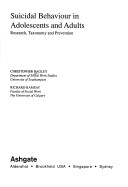CEDR (Centre for Evaluative Development Research) S.
1 total work
Suicidal Behaviours in Adolescents and Adults
by Christopher Bagley, Richard Ramsay, and Richard Ramsey
Published 20 August 1997
The chapters in this study reflect 15 years of research in the Canadian province of Alberta, a region which has the highest suicide rate in young males in Canada. The book attempts to answer questions such as: what meanings and values do contrasted groups attach to the concept of suicide?; is the greater prevalence of suicidal behaviour in the young reflected in the meanings they attach to suicidal actions?; are young people experiencing more stress than the older generation?; do some forms of child abuse, particularly sexual abuse, have a sequel in suicidal behaviours and related mental health problems in young adult women, and in adolescent males and females; are the struggles for homosexual identity associated with suicidal behaviours in young males; and the role of poor self-esteem. In addition it asks: can this causal chain of events be reversed by therapeutic intervention which uses group counselling to increase self-esteem and enhance social support?; are Aboriginal people in the Province of Alberta at special risk for suicide; are their sub-types of suicide which imply different kinds of preventive and treatment strategies?; has the increase in the male youth suicide rate been associated with an increase in diagnosable psychiatric disorders?
; how can knowledge about suicide in high rate area be translated into a comprehensive strategy of suicide prevention education; and do telephone crisis lines and crisis centres prevent suicidal behaviours?.
; how can knowledge about suicide in high rate area be translated into a comprehensive strategy of suicide prevention education; and do telephone crisis lines and crisis centres prevent suicidal behaviours?.
